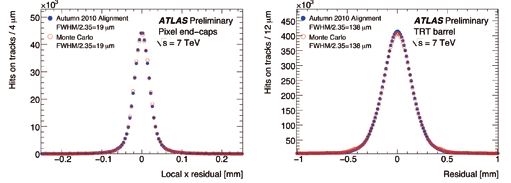
ATLAS e-News
23 February 2011
Getting the Inner Detector in line
15 November 2010

Residual distribution for Pixel end-caps (left) and TRT barrel (right) in the data reconstructed using the Autumn 2010 alignment constants (blue full) compared to Monte Carlo simulated with perfectly aligned geometry (open red).
The reprocessing of the 2010 data sample is almost finished and includes a substantial improvement in the Inner Detector (ID) alignment. This will impact all track-based physics analyses, and in particular the b-tagging and measurements using high pΤ tracks.
The challenge of aligning the ATLAS ID lies in the complexity of the tracker. It consists of 5,832 silicon modules (Pixel and SCT detectors) and 350,000 straw drift tubes (TRT), which are organized in layers in the barrel and in discs in the end-caps. In order to achieve the physics goals of ATLAS, the position and orientation of each detector element has to be known to very high precision (∼1 µm), as compared to the precision known after installation (100 - 1000 µm).
After aligning the ATLAS ID with cosmic-ray tracks in 2008 and 2009, and subsequently using the first collision data taken at √s = 900 GeV, the first reasonable understanding of the alignment of the whole ID was established in the Spring 2010. The alignment produced for the May reprocessing represented substantial improvement for the end-caps, which could not be well aligned using cosmic ray data. Even though this alignment allowed for reasonable quality physics measurements for the summer conferences as well as for the first ATLAS papers, it was clear that a lot more understanding was needed.
The Autumn 2010 alignment production profited from several improvements. The main difference to previous alignment was using collision data recorded at √s = 7 TeV. Compared to the 900 GeV dataset, this dataset contains a significantly larger number of high momentum tracks. Such tracks suffer much less from multiple Coulomb scattering effects and have an increased sensitivity to misalignments. In addition high momentum cosmic tracks were used that were recorded in parallel to collisions during empty bunches.
Other important improvements came from moving to the new track-based alignment software, which has been in development and validation for over a year. The new software has been developed together with the Muon Spectrometer people and it allows aligning all parts of the ATLAS tracking system at the same time at an arbitrary level of granularity. For the ID, it means that in the Autumn alignment production, the silicon and TRT sub-systems were aligned together in one go for the first time. In addition to the simplification of the alignment procedure, it also means that the TRT measurements on track impose constraints on the alignment of the silicon detectors and vice versa.
Moreover, the ID alignment group was concentrating especially on improving the understanding of end-caps whose alignment was problematic with previous datasets. The new data allowed significant reduction of misalignments and brought the level of understanding of the end-cap alignment close to that of the barrel.
The TRT specific improvements include the new wire-level alignment, which was done for the first time during this alignment campaign. The new alignment framework provides possibility to run alignment in this setup in a natural way and is also not limited by the huge number of degrees of freedom. The main motivation for performing the alignment at this level was the observation of systematic misalignments of groups of adjacent wires in both barrel and end-caps that could potentially bias the measurement of track parameters. Wire-level alignment successfully removed these systematic misalignments.
In the Autumn alignment, all ID sub-detectors have seen an improvement in performance. This resulted in narrower track-hit residual distributions, better track parameter resolutions as well as improved resolution of invariant mass of the Ζ boson in Ζ → µµ decays, especially in the end-caps. In the last stage of the alignment production, the correction of the deformation of wafers in the pixel barrel, known from the survey measurements, was introduced in the track reconstruction. This led to further significant improvement in the pixel resolution and should have strong positive impact on the b-tagging performance.
Of course, the alignment job is not finished yet. With increasing statistics and improving alignment precision new effects can appear, which will have to be addressed. Potential movements of the detector and "weak modes” (systematic distortions which do not change the χ2 of the track but bias track parameters) are just two out of the many possibilities we will have to keep an eye on.
All this progress in the ID alignment was achieved thanks to the work of many people who have been involved for several years. Since it is not likely that we will run out of challenging topics in the near future, enthusiastic volunteers are always welcome.
 Daniel Kollar
|